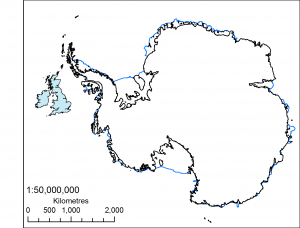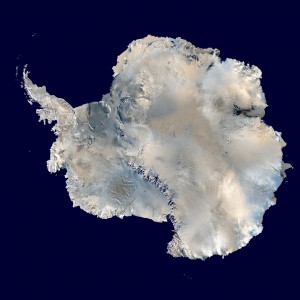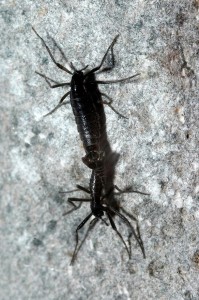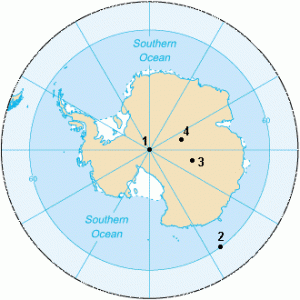Here are my top ten Antarctic Facts!
- Antarctica is 14,000,000 km2 in size: this makes it the world’s fifth-largest continent, after Asia, Africa, North America and South America.

How does the size of Antarctica compare with the size of Britain? Note both countries are drawn to the same scale - 10 children have been born in Antarctica, to Argentinian and Chilean parents.
- There are 82 scientific bases in Antarctica, supporting a total continent-wide population of around 4000 people in summer and 1000 people in winter (not counting people on ships).

The Chilean Base Prat on Greenwich Island, South Sandwich Islands - The area south of 60 degrees South is designated by the Antarctic Treaty is a scientific preserve, and military activity is banned. The treaty came into force in 1961 and is currently signed by 50 countries. The treaty encourages scientific cooperation and does not recognise, dispute nor establish sovereign claims.

Amundsen-Scott South Pole Station, with the ceremonial South Pole and the flags for the original 12 signatory nations of the Antarctic Treaty. Picture by the US Antarctic Program, National Science Foundation. From Wikimedia Commons. - Antarctica is entirely surrounded by the Antarctic Circumpolar Current, and this current helps keep Antarctica cold.

Antarctica. An orthographic projection of NASA’s Blue Marble data set (1 km resolution global satellite composite). “MODIS observations of polar sea ice were combined with observations of Antarctica made by the National Oceanic and Atmospheric Administration’s AVHRR sensor—the Advanced Very High Resolution Radiometer.” Image was generated using a custom C program for handling the Blue Marble files, with orthographic projection formulas. Source: Wikiemedia Commons - The largest land animal in Antarctica is a wingless midge, Belgica antarctica, which is less than 1.3 cm long. All the other, larger, animals in Antarctica are considered marine animals, meaning that they feed and live largely in the ocean. This includes seals and penguins, Antarctica’s most famous residents. In addition, Antarctica is the only continent with no indigenous species of ant.

Belgica Antarctica, a wingless midge that’s the largest land animal in Antarctica. The larger female is at the top of the picture. From Wikimedia Commons. - Antarctica holds enough ice to raise global sea levels by 58 m if it all melted. It contains 26.5 million km3 of ice. The Antarctic Ice Sheet has an average thickness of 2126 m, and the deepest part is Bryd Glacier, the base of which lies 2870 m below sea level. The thickest part of the Antarctic Ice Sheet is Astrolabe Subglacial Basin, where the ice is 4776 m thick. The Greenland and Antarctic ice sheets combined hold 99% of all the world’s fresh water.

Antarctica’s subglacial topography, with main mountain ranges shown. - Ice flow in Antarctica concentrates meteorites in certain places. They show up well against the white snow, and their dark colour encourages them to melt out. ANSMET continues to search out meteorites. Over 16,000 have been collected since 1976.

Ice flow in Antarctica concentrates meteorites. From NASA, Wikimedia Commons. - The Geographic South Pole in Antarctica is the axis of the Earth’s rotation. It is directly opposite the North Pole, but whilst the North Pole is in the Arctic Ocean, the South Pole is on a huge ice sheet. The South Pole is at 2835 m above sea level and lies 1300 km from the nearest open water (in the Bay of Whales). The Antarctic Ice Sheet is 2700 m thick here. The South Magnetic Pole is where the Earth’s geomatnetic field lines are pointed vertically upwards. The South Geomagnetic Pole is the point where the axis of a best-fitting tilted dipole (like a bar magnet) placed at the centre of the Earth intersects the Earth’s surface in the southern hemisphere.

1: South Geographic Pole, 2: South Magnetic Pole (2007), 3: South Geomagnetic Pole, 4: South Pole of Inaccessibility. United States Government, Wikimedia Commons. - The South Pole in Antarctica may be hard to get to, but not as hard as the South Pole of Inaccessibility. This is the most remote place in Antarctica, being furthest from all coastlines. It is 878 km from the South Pole, 3718 m high (different means of measurement do place the South Pole of Inaccessibility in slightly different places).
Got your own cool Antarctic fact? Add a comment in the box below.
Go to top.

Very interesting site, I found today! Thanks a lot for all information.
Antarctica has my interest for a long time, since I red the book of Cherry Absley Garrard: “The worst journey in the world”, telling about an expedition from the basis station to the area where the Adelaide penguins fed their young ones, in bizarre circumstances and all in the dark. He gathered an egg indeed, but it broke before he reached the “headquarters” I believe. He also wrote about the queeste of Scott and his four companions to reach the exact pole and the disaster that happened just before their return to the basis station. He tried to travel with ponies but the only thing they were good for, was to be consumed. For the ponies the journey was too difficult and they were of no help to pull the sledges. This book of Apsley Cherry Garrard is the best book I ever read, I loved it. Must read it again I think.
I dreamed of participating on an expedition too, knowing that (luckily) it would never happen. Only the most strong people can do such a thing. But reading about it is very good!
A journey to the pole nowadays however is verry different from the time of the Scott expedicion, or Shackleton c.s. And a journey to the North Pole will soon be impossible forever, for the mass of ice is too unstable for men. And for polar beers too. Sorry beers, we did it all wrong, really.
Greetings,
Regarding item’s # 3 picture (Chilean Base Prat) please notice that Greenwich Island belongs to the South Shetland (not South Sandwich) group.
Wow, this is a fun and interesting site. Just to be a stickler, though, regarding #6 (Belgica antarctica) where it says “All the other, larger, animals in Antarctica are considered marine animals, meaning that they feed and live largely in the ocean.”, there is a larger fresh water animal that is not a marine animal – the antarctic fairy shrimp. It lives in seasonal fresh water pools and rivulets, over wintering in the egg phase. (https://en.wikipedia.org/wiki/Branchinecta_gaini)
My mother and father would say I was “Whacky” to go out in winter without a hat.
Imagine if I did that in Antarctica.
I believe the result would be in the obits, rather than the sports page.
My mother and father would say I was “Whacky” to go out in winter without a hat.
Imagine if I did that in Antarctica.
I believe the result would be in the obits, rather than the sports page.
Wow! Interesting site, cool facts for things like homework or to find out more about Antarica.
so enteresting is Arntactica it’s what i should experience with my own eyes, rather than to be told
GOD really made it special!
This is so interesting! This is very good for homework, And kids would think it is very satisfying.
such cool facts our third grade class loved them!
tynmuii